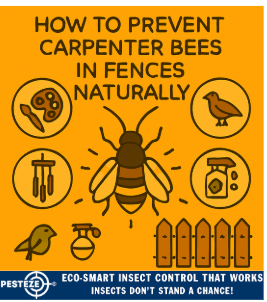HOW TO PREVENT CARPENTER BEES IN FENCES NATURALLY

HOW TO PREVENT CARPENTER BEES IN FENCES NATURALLY
SUMMARY
Carpenter bees are beneficial pollinators, but they can cause serious damage when they bore holes into wooden fences. Over time, their nesting tunnels weaken wood and create unsightly damage. Luckily, with preventive treatments, natural repellents, and regular upkeep, you can protect your fences from carpenter bees without harsh chemicals.
FEATURES
-
Seal and Paint Fence Wood – Finished surfaces are less attractive to carpenter bees.
-
Apply Citrus or Essential Oil Sprays – Scents like citrus, peppermint, and eucalyptus deter bees.
-
Repair Holes Promptly – Fill and seal drilled tunnels before bees reuse them.
-
Install Protective Mesh – Cover vulnerable posts and beams with netting.
-
Offer Alternative Nesting Areas – Use bee houses to redirect activity away from fences.
-
Maintain Fences Seasonally – Inspect and reinforce wood each spring.
GUIDE DESCRIPTION
Carpenter bees often target untreated, weathered, or exposed wood, making wooden fences a common nesting site. While these bees play an important role in pollination, their tunneling weakens wood and can compromise fence durability. Preventing carpenter bee damage requires a proactive approach that keeps fences unattractive to nesting bees.
Start by sealing and painting fence wood. Carpenter bees prefer raw or untreated wood, so applying stain, paint, or a waterproof sealant creates a protective barrier. A well-coated surface is far less appealing, and routine touch-ups extend protection year after year.
For an added natural deterrent, try citrus or essential oil sprays. Boiling citrus peels in water produces a repellent spray that can be applied directly to wooden surfaces. Essential oils like peppermint, tea tree, and eucalyptus are also effective when diluted with water. Regular spraying, especially in spring, helps discourage bees from hovering around fences.
If carpenter bees have already drilled holes, repair them promptly. Fill tunnels with wood filler or caulk, sand smooth, and reseal the surface. This not only prevents reuse but also restores the fence’s integrity.
Adding protective mesh to high-risk spots, such as fence posts, can physically block bees from drilling. Netting or fine wire mesh is especially useful in shaded or secluded areas where bees prefer to nest.
Another effective strategy is to provide alternative nesting areas. Bee houses placed away from fences give carpenter bees a safe and suitable spot to nest, reducing the likelihood they’ll choose your fence.
Finally, regular maintenance is key. Inspect fences each spring for round entry holes or sawdust shavings—signs of carpenter bee activity. Addressing issues early prevents larger infestations and prolongs the lifespan of your fence.
By sealing wood, using natural repellents, repairing holes, and maintaining fences, you can prevent carpenter bees safely. These eco-friendly methods protect your outdoor structures while supporting pollinator health.
- Shashank Rongali


Comments 0